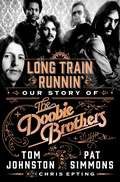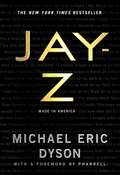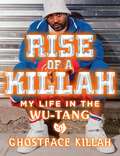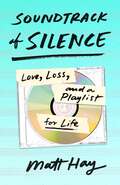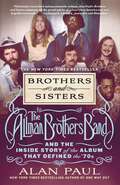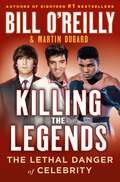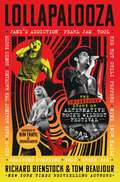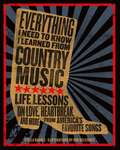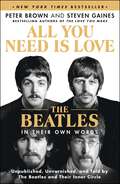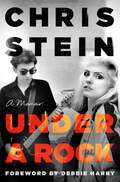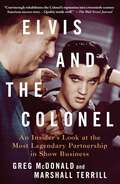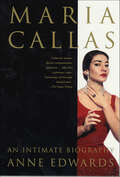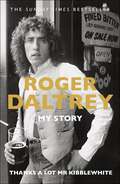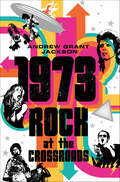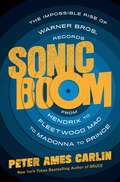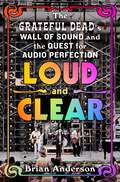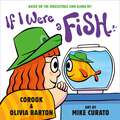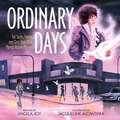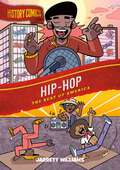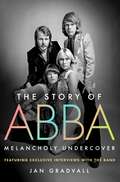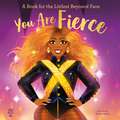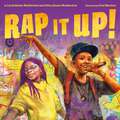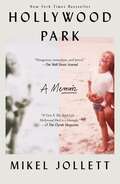- Table View
- List View
Long Train Runnin': Our Story of The Doobie Brothers
by Pat Simmons Tom JohnstonFor the first time, the incredible true story of the legendary band, The Doobie Brothers, written by founding members Pat Simmons and Tom Johnston.Only a very few rock bands have had the longevity, success, and drama of The Doobie Brothers. Born out of late 1960s NorCal, and led by Pat Simmons and Tom Johnston, they stood alongside their contemporaries The Grateful Dead, The Allman Brothers, and many others as an iconic American rock band. The train was rolling along, hits were flowing like wine, and arenas were packed with fans who wanted to see them live...then Tom Johnston, the band’s front man and lead guitarist, became ill and had to leave.The Doobies' train came to a screeching halt. All of a sudden the band started contemplating the end of the road only seven years into their career, just as things were taking off. But Pat Simmons made sure they were far from the end and began the process of keeping the band together through most of the next decade.A soul-steeped backup singer for Steely Dan named Michael McDonald took a shot at singing some of the Doobies' songs on tour, and all of a sudden a new chapter in the Doobie Brothers' story began. The band expanded their sound and had even more hits with their new front addition. Tom recovered from his health issues, but the band had moved on. When it came time for a reunion concert in the ’80s, Tom got the call and was back in the mix. Led once again by Pat and Tom, The Doobie Brothers have been touring ever since and maintain a massive fan base the world over.Never before have Pat and Tom shared their story, in their own words. In Long Train Runnin’ they’ll change that.
JAY-Z: Made in America
by Michael Dyson"Dyson's incisive analysis of JAY-Z's brilliance not only offers a brief history of hip-hop's critical place in American culture, but also hints at how we can best move forward." —Questlove <P><P>JAY-Z: Made in America is the fruit of Michael Eric Dyson’s decade of teaching the work of one of the greatest poets this nation has produced, as gifted a wordsmith as Walt Whitman, Robert Frost and Rita Dove. But as a rapper, he’s sometimes not given the credit he deserves for just how great an artist he’s been for so long. <P><P>This book wrestles with the biggest themes of JAY-Z's career, including hustling, and it recognizes the way that he’s always weaved politics into his music, making important statements about race, criminal justice, black wealth and social injustice. As he enters his fifties, and to mark his thirty years as a recording artist, this is the perfect time to take a look at JAY-Z’s career and his role in making this nation what it is today. In many ways, this is JAY-Z’s America as much as it’s Pelosi’s America, or Trump’s America, or Martin Luther King’s America. JAY-Z has given this country a language to think with and words to live by. <P><P>Featuring a Foreword by Pharrell <P><P><b> A New York Times Bestseller </b>
Rise of a Killah
by Ghostface KillahThe story of the celebrated rapper and the iconic Wu-Tang Clan, told by one of its founding members Dennis Coles—aka Ghostface Killah—is a co-founder of the Wu-Tang Clan, a legendary hip hop group who established themselves by breaking all the rules, taking their music to the streets during hip hop’s golden era on a decade-long wave of releasing anthem after classic anthem, and serving as the foundation of modern hip hop. An all-star cast who formed like Voltron to establish the pillars that serve as the foundation of modern hip hop and released seminal albums that have stood the test of time.Rise of a Killah is Ghost’s autobiography, focusing on the people, places and events that mean the most to him as he enters his fourth decade writing and performing. It’s a beautiful and intense book, going back to the creative ferment that led to Ghost’s first handwritten rhymes. Dive into Ghost’s defining personal moments, his battles with his personal demons, his journey to Africa, his religious viewpoints, his childhood in Staten Island, and his commitment to his family (including his two brothers with muscular dystrophy), from the Clan’s early successes to the pinnacle of Ghost’s career touring and spreading his wings as a solo artist, fashion icon, and trendsetter. Exclusive photos and memorabilia, as well as graphic art commissioned for this book, make Rise of a Killah both a memoir and a unique visual record, a “real feel” narrative of Ghost’s life as he sees it, a one of a kind holy grail for Wu-Tang and Ghost fans alike.
Soundtrack of Silence: Love, Loss, and a Playlist for Life
by Matt HayAn inspiring memoir of a young man who discovered he was going completely deaf just at the moment he’d fallen in love for the first time.As a child, Matt Hay didn’t know his hearing wasn’t the way everyone else processed sound—because of the workarounds he did to fit in, even the school nurse didn’t catch his condition at the annual hearing and vision checks. But by the time he was a prospective college student and couldn’t pass the entrance requirements for West Point, Hay’s condition, generated by a tumor, was unavoidable: his hearing was going, and fast.A personal soundtrack was Hay’s determined compensation for his condition. As a typical Midwestern kid growing up in the 1980s whose life events were pegged to pop music, Hay planned to commit his favorite songs to memory. He prepared a mental playlist of the bands he loved and created a way to tap into his most resonant memories. And the track he needed to cement most clearly? The one he and his new girlfriend, Nora—the love of his life—listened to in the car on their first date.Made vivid with references to instantly recognizable songs—from the Eagles to Elton John, Bob Marley to Bing Crosby, U2 to Peter Frampton—Soundtrack of Silence asks readers to run the soundtrack of their own lives through their minds. It’s an involving memoir of loss and disability, and, ultimately, a both unique and universal love story.
Brothers and Sisters: The Allman Brothers Band and the Inside Story of the Album That Defined the '70s
by Alan PaulTHE INSTANT NEW YORK TIMES BESTSELLERNew York Times bestselling author Alan Paul's in-depth narrative look at the Allman Brothers' most successful album, and a portrait of an era in rock and roll and American history.The Allman Brothers Band’s Brothers and Sisters was not only the band’s bestselling album, at over seven million copies sold, but it was also a powerfully influential release, both musically and culturally, one whose influence continues to be profoundly felt.Celebrating the album’s fiftieth anniversary, Brothers and Sisters the book delves into the making of the album, while also presenting a broader cultural history of the era, based on first-person interviews, historical documents, and in-depth research.Brothers and Sisters traces the making of the template-shaping record alongside the stories of how the Allman Brothers came to the rescue of a flailing Jimmy Carter presidential campaign and helped get the former governor of Georgia elected president; how Gregg Allman’s marriage to Cher was an early harbinger of an emerging celebrity media culture; and how the band’s success led to internal fissures. The book also examines the Allman Brothers' relationship with the Grateful Dead—including the most in-depth reporting ever on the Summer Jam at Watkins Glen, the largest rock festival ever—and describes how they inspired bands like Lynyrd Skynyrd, helping create the southern rock genre.With exclusive access to hundreds of hours of never-before-heard interviews with every major player, including Dickey Betts and Gregg Allman, conducted by Allman Brothers Band archivist, photographer, and “Tour Mystic” Kirk West, Brothers and Sisters is an honest assessment of the band’s career, history, and highs and lows.
Killing the Legends: The Lethal Danger of Celebrity (Killing series #12)
by Bill O'Reilly Martin DugardIn the next book in the multimillion-selling Killing Series, Bill O'Reilly and Martin Dugard tell the larger-than-life stories of Elvis Presley, John Lennon, and Muhammad Ali.The King is dead. The Walrus is shot. The Greatest is no more.Elvis Presley, John Lennon, and Muhammad Ali. These three icons changed not only the worlds of music, film, and sports, but the world itself. Their faces were known everywhere, in every nation, across every culture. And their stories became larger than life—until their lives spun out of control at the hands of those they most trusted.In Killing the Legends, Bill O’Reilly and Martin Dugard explore the lives, legacies, and tragic deaths of three of the most famous people of the 20th century. Each experienced immense success, then failures that forced them to change; each faced the challenge of growing old in fields that privilege youth; and finally, each became isolated, cocooned by wealth but vulnerable to the demands of those in their innermost circles. Dramatic, insightful, and immensely entertaining, Killing the Legends is the twelfth book in O’Reilly and Dugard’s Killing series: the most popular series of narrative history books in the world, with more than 18 million copies in print.
Lollapalooza: The Uncensored Story of Alternative Rock's Wildest Festival
by Tom Beaujour Richard BienstockWith a Foreword by Kim Thayil of Soundgarden!The definitive, no-holds-barred oral history of 1990s alt-rock festival Lollapalooza―told by the musicians, roadies, and industry insiders who lived it. From the New York Times bestselling authors of Nothin’ But A Good Time.In Lollapalooza: The Uncensored Story of Alternative Rock's Wildest Festival, New York Times bestselling authors Richard Bienstock and Tom Beaujour tell the no-holds-barred history of the iconic music festival. Through hundreds of new interviews with artists, tour founders, festival organizers, promoters, publicists, sideshow freaks, stage crews, record label execs, reporters, roadies and more, Lollapalooza chronicles the tour’s pioneering 1991-1997 run, and, in the process, alternative rock’s rise – as well as the reverberations that led to a massive shift in the music industry and the culture at large.Lollapalooza features original interviews with some of the biggest names in music, including Perry Farrell and Jane’s Addiction, Pearl Jam, Soundgarden, Nine Inch Nails, Sonic Youth, Tool, Smashing Pumpkins, Ice-T, Rage Against the Machine, Green Day, Patti Smith, Alice in Chains, Metallica and many more. Conceived by Farrell as a farewell tour for Jane's Addiction, Lollapalooza’s inaugural outing across the U.S. in the summer of 1991 helped to coalesce an ideology and aesthetic that not only washed over popular music but seeped into fashion, film, television, literature, food, politics and more. Throughout the decade, Lollapalooza offered a vast and diverse ensemble of bands, breaking barriers of genre and uniting alternative rock, heavy metal, punk, hip-hop, industrial, goth, avant-garde, spoken word, electronic dance music and other styles under one big tent, and setting the template for the modern American music festival and the scores of other contemporary destination fests that are now an integral part of how audiences experience live music.Unorthodox not just in music, Lollapalooza also spotlighted visual arts, nonprofit organizations, political outfits and even the occasional freak show, offering a tantalizing cocktail of culture, art, and activism that, taken together, defined the alternative mindset that dominated the 1990s. Echoes of its impact reverberate strongly today – cemented by annual sell-outs at destination events all over the world, an estimation of 400,000 attendees at the flagship Chicago fest each summer, and a spot among the world's largest and longest-running music festivals. A nostalgic look back at 1990s music and culture, Lollapalooza traces the festival’s groundbreaking origins, following the tour as it progresses through the decade, and documenting the action onstage, backstage, and behind-the-scenes in detailed and uncensored and sometimes shocking first-person accounts. This is the story of Lollapalooza and the 1990s alternative rock revolution.
Everything I Need To Know I Learned From Country Music: Life Lessons on Love, Heartbreak, and More from America's Favorite Songs
by Stella BarnesEverything I Need To Know I Learned From Country Music is a Nashville tribute perfect for any country music lover from Stella Barnes, featuring illustrations by Bob Delevante.You can always count on country music!Take it from your favorite country artists! Whether you’re nursing a beer and a broken heart or you’re raising a glass to the little things in life, they’re right there by your side with the lyrics you need to hear most. Now, you can find country’s best lessons right here in Everything I Need to Know I Learned from Country Music.- Rediscover and reflect on the songs that have seen you through it all- Get the inside scoop on songs from country greats like Dolly Parton, Johnny Cash, Tim McGraw, Carrie Underwood, and more- Enjoy more than 60 illustrated lyrics from their songsSpanning seven decades of songs that speak straight from the heart, Everything I Need to Know I Learned from Country Music is more than just a thoughtful gift for country music fans—it’s a salute to American life!
All You Need Is Love: Unpublished, Unvarnished, and Told by The Beatles and Their Inner Circle
by Peter Brown Steven GainesTHE NEW YORK TIMES BESTSELLERAn oral history of The Beatles from never-before-seen interviews.All You Need Is Love is a groundbreaking oral history of the one of the most enduring musical acts of all time. The material is comprised of intimate interviews with Paul McCartney, Yoko Ono, George Harrison, Ringo Starr, their families, friends and business associates that were conducted by Beatles intimate Peter Brown and author Steven Gaines in 1980-1981 during the preparation of their international bestseller, The Love You Make, which spent four months on the New York Times bestseller list in 1983 and remains the biggest selling biography worldwide about the Beatles Only a small portion of the contents of these transcribed interviews have ever been revealed. The interviews are unique and candid. The information, stories, and experiences, and the authority of the people who relate to them, have historic value. No collection like this can ever be assembled again. In addition to interviews with Paul, Yoko, Ringo and George, Brown and Gaines also include interviews from ex-wives Cynthia Lennon, Pattie Harrison Clapton, and Maureen Starkey, as well as the major social and business figures of the Beatles’ inner circle. Among other sought-after information the interviews contribute definitively as to why the Beatles broke up.
Under a Rock: A Memoir
by Chris SteinForeword by Debbie Harry"A Downtown Memory" by Romy AshbyDebbie Harry defined iconic band Blondie’s look. Chris Stein—her performing partner, lover, and lifelong friend—was its architect and defined its sound. “Parallel Lines”, their third album, catapulted to #1, sold 20 million copies, and launched singles like “Heart of Glass”, "Hangin' On the Telephone," and “One Way or Another”, providing the beat when Bianca Jagger and Halston danced at Studio 54 and the soundtrack to every 1970’s punk-soundtracked romance. Chris Stein knows how to tell a story. Under A Rock is his nothing-spared autobiography. It's about the founding of the band, ascending to the heights of pop success, and the hazards of fortune.Famous names march through these pages—Warhol, Bowie, Jean-Michel Basquiat, and more–but you can get famous names anywhere. What you can’t get anywhere else is a plunge into the moments that made a giant 1980's artistic sensation. Stein takes us there in this revelatory, propulsive, distinctive memoir.
Elvis and the Colonel: An Insider's Look at the Most Legendary Partnership in Show Business
by Greg McDonald Marshall TerrillA fresh biography of legendary entertainment manager Colonel Tom Parker, with a contrarian and corrective point of view.Colonel Tom Parker, often reviled in his time, led the strategy from the earliest days of Elvis's career. Together, they built the most legendary partnership in show business. For the first time, Colonel Parker's story is told by an insider, Greg McDonald, who worked under Parker for years. Never-before-heard stories of Parker's collaboration with Elvis reveal the man behind the legend and the strategies that made Elvis a commercial groundbreaker.Ingrained lore has it that Parker took advantage of "poor country boy" Elvis to sign the singer who became "The King". But Elvis and the Colonel shows that Elvis was not foolish when it came to business arrangements. This book is full of stories of innovations Parker made with his star client, including:--ingenious merchandising (eg, selling both "I love Elvis" and "I hate Elvis" buttons)--licensing and branding, from suits to toys, ashtrays to guitars--establishing The King as an artist-in-residence in Las Vegas--creating televised concert events, like Elvis' Christmas specialMany of the practices Parker established are still deployed today by most major agencies. Parker's experience as a carny and an immigrant shaped his management style when he was at his peak, showing how he adapted big top practices to the big time. The heart of Elvis and the Colonel is the long, strong, warm and complex relationship between two iconic men.
Maria Callas: An Intimate Biography
by Anne EdwardsFrom the New York Times bestselling biographer Anne Edwards comes the irresistible true story of the lives and loves of the great opera diva, Maria Callas.Maria Callas continues to mesmerize us decades after her death, not only because she was indisputably the greatest opera diva of the 20th century, but also because both her life and death were shrouded in a Machiavellian web of scandal, mystery and deception. Now Anne Edwards, well known for her revealing and insightful biographies of some of the world's most noted women, tells the intimate story of Maria Callas—her loves, her life, and her music, revealing the true woman behind the headlines, gossip and speculation.The second daughter of Greek immigrant parents, Maria found herself in the grasp of an overwhelmingly ambitious mother who took her away from her native New York and the father she loved, to a Greece on the eve of the Second World War. From there, we learn of the hardships, loves and triumphs Maria experienced in her professional and personal life. We are introduced to the men who marked Callas forever—Luchino Visconti, the brilliant homosexual director who she loved hopelessly, Giovanni Battista Meneghini, the husband thirty years her senior who used her for his own ambitions, as had her mother, and Aristotle Onassis, who put an end to their historic love affair by discarding her for the widowed Jacqueline Kennedy. Throughout her life, Callas waged a constant battle with her weight, a battle she eventually won, transforming herself from an ugly duckling into the slim and glamorous diva who transformed opera forever, whose recordings are legend, and whose life is the stuff of which tabloids are made. Anne Edwards goes deeper than previous biographies of Maria Callas have dared. She draws upon intensive research to refute the story of Callas's "mystery child" by Onassis, and she reveals the true circumstances of the years preceding Callas's death, including the deception perpetrated by her close and trusted friend. As in her portraits of other brilliant, star-crossed women, Edwards brings Maria Callas—the intimate Callas—alive.
Thanks a Lot Mr Kibblewhite: My Story
by Roger DaltreyThe frontman of one of the greatest bands of all time tells the story of his rise from nothing to rock 'n' roll megastar, and his wild journey as the voice of The Who.“It’s taken me three years to unpack the events of my life, to remember who did what when and why, to separate the myths from the reality, to unravel what really happened at the Holiday Inn on Keith Moon’s 21st birthday,” says Roger Daltrey, the powerhouse vocalist of The Who. The result of this introspection is a remarkable memoir, instantly captivating, funny and frank, chock-full of well-earned wisdom and one-of-a-kind anecdotes from a raucous life that spans a tumultuous time of change in Britain and America. Born during the air bombing of London in 1944, Daltrey fought his way (literally) through school and poverty and began to assemble the band that would become The Who while working at a sheet metal factory in 1961. In Daltrey’s voice, the familiar stories—how they got into smashing up their kit, the infighting, Keith Moon’s antics—take on a new, intimate life. Also here is the creative journey through the unforgettable hits including My Generation, Substitute, Pinball Wizard, and the great albums, Who’s Next, Tommy, and Quadrophenia. Amidst all the music and mayhem, the drugs, the premature deaths, the ruined hotel rooms, Roger is our perfect narrator, remaining sober (relatively) and observant and determined to make The Who bigger and bigger. Not only his personal story, this is the definitive biography of The Who.
1973: Rock At The Crossroads
by Andrew Grant JacksonA fascinating account of the music and epic social change of 1973, a defining year for David Bowie, Bruce Springsteen, Pink Floyd, Elton John, the Rolling Stones, Eagles, Elvis Presley, and the former members of The Beatles. 1973 was the year rock hit its peak while splintering—just like the rest of the world. Ziggy Stardust travelled to America in David Bowie’s Aladdin Sane. The Dark Side of the Moon began its epic run on the Billboard charts, inspired by the madness of Pink Floyd's founder, while all four former Beatles scored top ten albums, two hitting #1. FM battled AM, and Motown battled Philly on the charts, as the era of protest soul gave way to disco, while DJ Kool Herc gave birth to hip hop in the Bronx. The glam rock of the New York Dolls and Alice Cooper split into glam metal and punk. Hippies and rednecks made peace in Austin thanks to Willie Nelson, while outlaw country, country rock, and Southern rock each pointed toward modern country. The Allman Brothers, Grateful Dead, and the Band played the largest rock concert to date at Watkins Glen. Led Zep’s Houses of the Holy reflected the rise of funk and reggae. The singer songwriter movement led by Bob Dylan, Neil Young, and Joni Mitchell flourished at the Troubadour and Max’s Kansas City, where Bruce Springsteen and Bob Marley shared bill. Elvis Presley’s Aloha from Hawaii via Satellite was NBC’s top-rated special of the year, while Elton John’s albums dominated the number one spot for two and a half months.Just as U.S. involvement in Vietnam drew to a close, Roe v. Wade ignited a new phase in the culture war. While the oil crisis imploded the American dream of endless prosperity, and Watergate’s walls closed in on Nixon, the music of 1973 both reflected a shattered world and brought us together.
Sonic Boom: The Impossible Rise of Warner Bros. Records, from Hendrix to Fleetwood Mac to Madonna to Prince
by Peter Ames CarlinFrom journalist Peter Ames Carlin—the New York Times bestselling music biographer who chronicled the lives and careers of Paul McCartney, Bruce Springsteen, the Beach Boys, and Paul Simon—Sonic Boom captures the rollicking story of the most successful record label in the history of rock and roll, Warner Bros Records, and the remarkable secret to its meteoric rise.The roster of Warner Brothers Records and its subsidiary labels reads like the roster of the Rock & Roll Hall of Fame: Jimi Hendrix, the Grateful Dead, Joni Mitchell, Neil Young, James Taylor, Fleetwood Mac, the Eagles, Prince, Van Halen, Madonna, Tom Petty, R.E.M., Red Hot Chili Peppers, and dozens of others. But the most compelling figures in the Warner Bros. story are the sagacious Mo Ostin and the unlikely crew of hippies, eccentrics, and enlightened execs who were the first in the music business to read the generational writing on the wall in the mid-1960s. By recruiting outsider artists and allowing them to make the music they wanted, Ostin and his staff transformed an out-of-touch company into the voice of a generation. Along the way, they revolutionized the music industry and, within just a few years, created the most successful record label in the history of the American music industry.How did they do it? It all goes back to the day in 1967 when the newly tapped label president Mo Ostin called his team together to share his grand strategy for the struggling company: “We need to stop trying to make hit records. Let’s just make good records and turn those into hits.”With that, Ostin ushered in a counterintuitive model that matched the counterculture. His offbeat crew reinvented the way business was done, giving their artists free rein while rejecting out-of-date methods of advertising, promotion, and distribution. And even as they set new standards for in-house weirdness, the upstarts’ experiments and innovations paid off, to the tune of hundreds of legendary hit albums.It may sound like a fairy tale, but once upon a time Warner Bros Records conquered the music business by focusing on the music rather than the business. Their story is as raucous as it is inspiring, pure entertainment that also maps a route to that holy grail: love and money.Includes black-and-white photographs
Loud and Clear: The Grateful Dead’s Wall of Sound and the Quest for Audio Perfection
by Brian AndersonTHE INSTANT NEW YORK TIMES BESTSELLERThe first book to tell the full story of the Grateful Dead’s “Wall of Sound,” an unprecedented and since unparalleled speaker system.Loud and Clear is the first book to tell the full story of the Grateful Dead’s “Wall of Sound,” an unprecedented and since unparalleled speaker system that was as tall as a school bus is long and more than a hundred feet wide. The band’s quest for roaring yet crystal clear sound began after their formation in 1965, colliding with the ‘60s progressive social climate.Over the next few years, the Dead’s growing crew of sound-obsessed techies and eccentric roadies took their speaker system to new technological heights. But as the Dead’s relentless, drug-fueled touring schedule met this increasingly burdensome yet sonically perfect machine, in 1974, the Wall brought the band to its knees. The two years of “Wall shows” are legend among Deadheads, and this character-driven tale about human ambition, achievement, and the limits of both on a larger-than-life scale has the potential to reach a wide range of music fans and readers of cultural history.Author Brian Anderson interviewed hundreds of people associated with the band and the construction of the Wall itself, including band members, roadies, tech wizards, fans and many more. This fascinating inside story of one of the most legendary rock bands of all time will appeal to Deadheads, music fans, audiophiles and many more.
Hispanic Star en español: Bad Bunny (Hispanic Star)
by Ann Dávila Cardinal Claudia Romo EdelmanLee sobre Bad Bunny, ganador del Premio Grammy y "Rey del Latin Trap," en la última entrega de la serie de atractivas biografías ilustradas de Hispanic Star, disponibles en inglés y español. Conoce al ganador del Premio Grammy Bad Bunny, aquel niño llamado Benito del barrio Almirante Sur de Vega Baja, Puerto Rico. El mayor de tres hermanos, Benito se crio en una familia que valoraba la música, las obras de caridad y mantenerse fiel a uno mismo; creencias que lleva consigo hasta hoy. Luego de alcanzar la fama en 2017, Bad Bunny fue reconocido como el Rey del Trap Latino, y se convirtió en el artista del año de Spotify, obteniendo el mayor número de reproducciones de un artista de habla no inglesa y liderando la lista desde 2020 hasta 2022. Un emblema para su generación, Bad Bunny demuestra que puedes ser exactamente quien eres y seguir tus pasiones hacia donde te dirijan.Hispanic Star celebra con orgullo a los héroes hispanos y latinos que han hecho contribuciones notables a la cultura estadounidense y han sido fuerzas innegables en la formación de su futuro.
Hispanic Star: Bad Bunny (Hispanic Star)
by Ann Dávila Cardinal Claudia Romo EdelmanRead about Bad Bunny, known as the King of Latin Trap, who is among the most groundbreaking and iconic Latinx heroes to have shaped our culture and the world in the latest installment of the Hispanic Star’s series of engaging, illustrated biography for young readers.Meet Grammy Award Winner Bad Bunny—once just a kid called Benito from the Almirante Sur barrio of Vega Baja, Puerto Rico. The oldest of three brothers, Benito grew up in a family that valued music, charity, and being true to oneself—beliefs he carries with him to this day. Following his rise to fame in 2017, Bad Bunny was recognized as the King of Latin Trap and became the first non-English-language act to be Spotify’s most-streamed artist of the year, leading the list from 2020 to 2022. An emblem of his generation, Bad Bunny shows that you can be exactly who you are and follow your passions wherever they may lead you.If you can see it, you can be it. Hispanic Star proudly celebrates Hispanic and Latinx heroes who have made remarkable contributions to American culture and have been undeniable forces in shaping its future.
If I Were a Fish
by Corook Olivia BartonFrom the creators of the viral hit song that is a joyous celebration about making the best of a very bad day comes If I Were a Fish - a gorgeously illustrated picture book explosion of positivity and love guaranteed to make you smile.From the musicians and viral TikTok creators of If I Were A Fish, Corook and Olivia Barton, comes a delightful picture book adaptation of their silly, happy song. Join Corook and Olivia as they grab a guitar and dive into the comforting world of what it might be like to be a fish instead, and together, they make the best of a bad day. Humans and fish alike are welcome to sing (or kazoo) along!How lucky are we?Of all the fish in the seaYou get to be you!And I get to be me!Brightly and beautifully illustrated by the award-winning Mike Curato, this inspiring song about surrounding yourself with the people that make you the happiest is a timely reminder that it’s always best to be yourself.
Ordinary Days: The Seeds, Sound, and City That Grew Prince Rogers Nelson
by Angela JoyA rhythmic, striking picture book biography of legendary singer/songwriter/performer Prince.Before he became a legend, he was just a boy… On an ordinary day, you could see him. A young boy named Prince Rogers Nelson, who had parents who fought, nowhere to call home, and a collection of memories turned into sound: the shouts of anger, the purr of pigeons, the roar of cars down a busy Minneapolis street, and the whisper of cold wind on budding lilac bushes. Other sounds joined in as he taught himself to play the guitar, piano, drums, and much more, leading to the day this ordinary boy began to make music—and became extraordinary. Black Is a Rainbow Color and Choosing Brave author Angela Joy’s exquisite words harmonize with acclaimed illustrator Jacqueline Alcántara’s sweeping art to create a tender, profound look into music icon Prince's early life and the moments that shaped him.Ordinary Days also includes an extensive author’s note and playlist of recommended Prince songs suitable for young listeners.
History Comics: The Beat of America (History Comics)
by Jarrett WilliamsMUSICAL REVOLUTION SWEEPS NATION AND BEYONDHow did a bunch of young people from the inner city create a genre of music that became a global phenomenon? From its humble origins at house parties in the Bronx, where DJs mixed old records to create new sounds, charismatic MCs let their clever lyrics flow, and B-boys and B-girls pioneered inventive dance moves, hip-hop quickly became a musical and cultural revolution. Hip-Hop: The Beat of AmericaMeet Aaliyah, a hip-hop superfan who is about to get a lesson in all things “old school” courtesy of her dad, who grew up in the 1970s when rap music first hit the scene. The pair take a day trip to the Bronx where Aaliyah discovers the many unsung heroes who helped create the foundations of the hip-hop we all enjoy today. So get ready to drop the beat, bust a move, and get down with some fresh rap knowledge!Perfect for readers of Can't Stop, Won't Stop and Nathan Hale's Hazardous tales.
The Story of ABBA: Melancholy Undercover
by Jan GradvallThrough exclusive interviews and over a decade of deep research, renowned music journalist Jan Gradvall explores the secrets to ABBA’s success.There has never been a group like ABBA. More than half a century after their songs were recorded, ABBA still make people the world over dance and sing their hearts out. In 2013, when the band had not been interviewed for over thirty years, Jan Gradvall was granted unique access to them for the next decade and the result is The Story of ABBA: Melancholy Undercover. Agnetha Fältskog, Björn Ulvaeus, Benny Andersson, and Anni-Frid Lyngstad all share their personal stories, their thoughts and their opinions about ABBA’s music more openly than ever before. Weaving in and out of their story, well-known international music critic Jan Gradvall reveals the context in which their unique sound developed and shows how the story of ABBA is also the story of Sweden and the globalization of pop culture.From their earliest hits in Sweden like “People Need Love” and “Ring, Ring” to their chart-topping international hits like “Dancing Queen,” “Gimme, Gimme, Gimme” and “Mama Mia!” to ABBA Voyage – their first album in forty years – and the two-million-ticket-selling eponymous concert-experience in London, it is undeniable that, in the history of pop culture and music, there has never been a group like ABBA. With remarkable intimacy, Gradvall’s sensational book brings readers closer than ever to one of the world’s most notoriously private groups.
You Are Fierce: A Book for the Littlest Beyoncé Fans (The Littlest Fans)
by Odd DotYou run the world, babyA talent that comes only once in a lifetimeA girl that wastes no timeFollow your dreams, work ‘til you hold it, and be inspired by the life of Queen Bey! This inspiring read aloud is a heartfelt wish for all children and a timeless introduction to one of the most awarded, iconic, and beloved musical artists of all time.Perfect for Beyoncé fans of all ages!
Rap It Up!
by Carole Boston Weatherford Jeffery Boston WeatherfordAspiring young rappers will delight in this infectious, read-aloud introduction to the poetry and craft of rap.From scribbling words on the page to spitting rhymes on the mic, a joyful narrator guides readers through the emotions, literary techniques, structures and motifs that help make rap so amazing. With vibrant illustrations that leap off the page, this book urges readers to believe in themselves and the power of their creativity.Celebratory and informative, Rap it Up! invites us to see where our imaginations may lead. Get ready to drop some beats, express yourself, and let the world hear what you've got to say!
Hollywood Park: A Memoir
by Mikel JollettPARK is a remarkable memoir of a tumultuous life. Mikel Jollett was born into one of the country’s most infamous cults, and subjected to a childhood filled with poverty, addiction, and emotional abuse. Yet, ultimately, his is a story of fierce love and family loyalty told in a raw, poetic voice that signals the emergence of a uniquely gifted writer. <P><P>We were never young. We were just too afraid of ourselves. No one told us who we were or what we were or where all our parents went. They would arrive like ghosts, visiting us for a morning, an afternoon. They would sit with us or walk around the grounds, to laugh or cry or toss us in the air while we screamed. Then they’d disappear again, for weeks, for months, for years, leaving us alone with our memories and dreams, our questions and confusion. … <P><P>So begins Hollywood Park, Mikel Jollett’s remarkable memoir. His story opens in an experimental commune in California, which later morphed into the Church of Synanon, one of the country’s most infamous and dangerous cults. Per the leader’s mandate, all children, including Jollett and his older brother, were separated from their parents when they were six months old, and handed over to the cult’s “School.” <P><P>After spending years in what was essentially an orphanage, Mikel escaped the cult one morning with his mother and older brother. But in many ways, life outside Synanon was even harder and more erratic.In his raw, poetic and powerful voice, Jollett portrays a childhood filled with abject poverty, trauma, emotional abuse, delinquency and the lure of drugs and alcohol. <P><P>Raised by a clinically depressed mother, tormented by his angry older brother, subjected to the unpredictability of troubled step-fathers and longing for contact with his father, a former heroin addict and ex-con, Jollett slowly, often painfully, builds a life that leads him to Stanford University and, eventually, to finding his voice as a writer and musician.Hollywood Park is told at first through the limited perspective of a child, and then broadens as Jollett begins to understand the world around him. Although Mikel Jollett’s story is filled with heartbreak, it is ultimately an unforgettable portrayal of love at its fiercest and most loyal. <P><P><b>A New York Times Bestseller</b>
